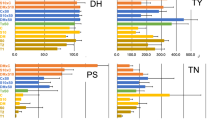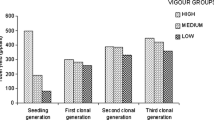Summary
To study the joint effects of homozygotization and polyploidization in potato, the performance has been examined of five potato genotypes at three (x, 2x, 4x) and two genotypes at two (x, 2x) ploidy levels. Six out of the seven genotypes studied were compared with their heterozygous diploid parental clone. In this way comparisons could be made between i) the heterozygous diploid and its monohaploid derivatives, ii) three or two ploidy levels per genotye and iii) homozygous di- and tetreploids and their heterozygous diploid source.
Large variation could be detected between monohaploids obtained from one diploid source. A striking increase in vigour was observed with somatic chromosome doubling from x to 2x, but less clearly from 2x to 4x. The relatively vigorous diploids showed a weaker response to tetraploidization than the less vigorous ones. The heterozygous diploid exceeded all homozygous di- and tetraploid derivatives in performance. The results of this study suggest positive gene dosage effects for tuber production more than for leaf area and plant height. The observations on plant vigour in homo- and heterozygotes suggest that dominance effects are stronger than additive gene effects. Owing to sterility problems, homozygous potato clones will presumably be of little importance for practical breeding.
Similar content being viewed by others
References
Breukelen, E. W. M.van, M. S., Ramanna & J. G. Th., Hermsen, 1975. Monohaploids (2n=x=12) from autotetraploid Solanum tuberosum (2n=4x=48) through two successive cycles of female parthenogenesis. Euphytica 24: 567–574.
Caroll, C. P. & R. J., Low, 1975. Flowering behaviour and seed fertility in dihaploid Solanum tuberosum. Potato Res. 18: 416–427.
Caroll, C. P. & R. J., Low, 1975. Aspects of male fertility in group Tuberosum dihaploids. Potato Res. 19: 109–121.
De, Maine, M. J., 1985. Shoot structure and morphology of dihaploid potatoes, their chromosome-doubled derivatives and parthenogenetic tetraploid parents. Potato Res. 28: 403–413.
Frandsen, N. O., 1967a. Haploid produktion aus einem Kartoffelzuchtmaterial mit intensiver Wildarteinkreuzung. Züchter 37: 120–134.
Frandsen, N. O., 1967b. Chimaren verschiedener Ploidiestufen aus haploiden Kartoffelklonen. Z. Pflanzenzüchtg. 57: 123–145.
Corea, T., 1970. Fertilität und Kreuzbarkeit der Dihaploiden von Solanum tuberosum L. Z. Pflanzenzüchtg. 64: 201–220.
Hermsen, J. G. Th. & J., Verdenius, 1973. Selection from Solanum tuberosum Group Phureja of genotypes combining high-frequency haploid induction with homozygosity embryo-spot. Euphytica 22: 244–259.
Peloquin, S. J. & R. W., Hougas, 1958. The fertility of two haploids of S. tuberosum. Science 128: 1340–1341.
Peloquin, S. J. & R. W., Hougas, 1960. Genetic variation among haploids of the common potato. Am. potato J. 37: 289–297.
Roest, S. & G. S., Bokelmann, 1976. Vegetative propagation of Solanum tuberosum L. in vitro. Potato Res. 19: 173–178.
Ross, R. W., L. A., Dionne & R. W., Hougas, 1967. Doubling the chromosome number of selected Solanum genotypes. Eur. Potato J. 44: 195–203.
Rowe, P. R., 1967. Performance of diploid and vegetative doubled clones of Phureja-haploid Tuberosum hybrids. Am. Potato J. 44: 263–271.
Sass, J. E., 1964. Botanical micro technique. Iowa State Univ. Press, Ames, Iowa, 228 pp.
Suchtelen, N. J.van, 1966. Investigation of dihaploid potatoes in the Netherlands. Eur. Potato J. 9: 64–68.
Uijtewaal, B. A., 1987. Ploidy variability in greenhouse cultured and in vitro propagated potato monohaploids (2n=x=12) as determined by flow cytometry. Plant Cell Reports 6: 252–255.
Uijtewaal, B. A., D. J., Huigen & J. G. Th., Hermsen, 1987a. Production of potato monohaploids (2n=x=12) through prickle pollination. Theor. Appl. Genet. 73: 751–758.
Uijtewaal, B. A., L. C. J. M. Suurs & E. Jacobsen, 1987b. Protoplast fusion of monohaploid (2n=x=12) potato clones; identification of somatic hybrids using malate dehydrogenase as a biochemical marker. Plant Sc. (in press.).
Author information
Authors and Affiliations
Rights and permissions
About this article
Cite this article
Uijtewaal, B.A., Jacobsen, E. & Hermsen, J.G.T. Morphology and vigour of monohaploid potato clones, their corresponding homozygous diploids and tetraploids and their heterozygous diploid parent. Euphytica 36, 745–753 (1987). https://doi.org/10.1007/BF00051857
Received:
Accepted:
Issue Date:
DOI: https://doi.org/10.1007/BF00051857




